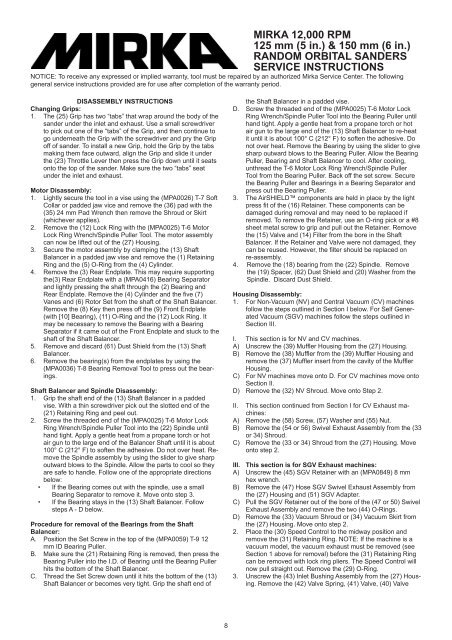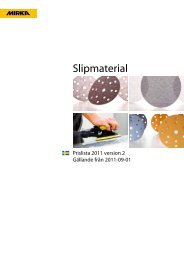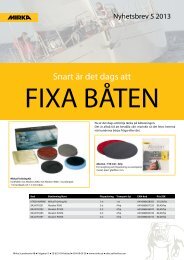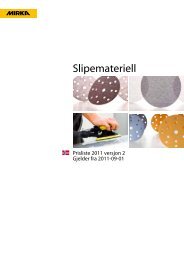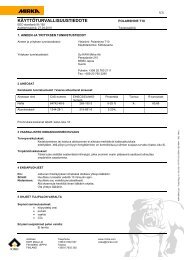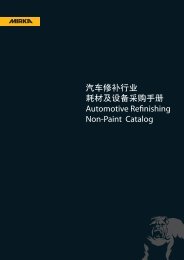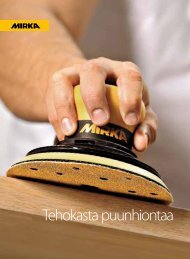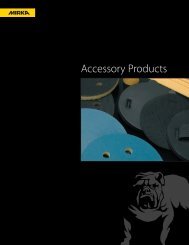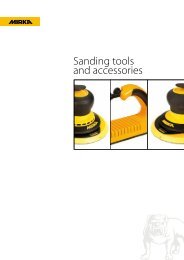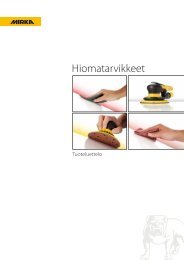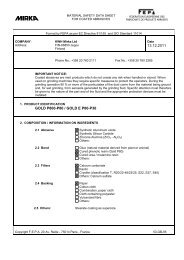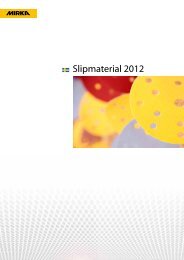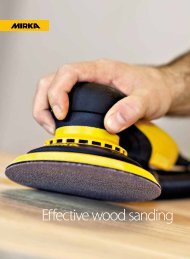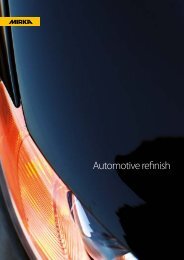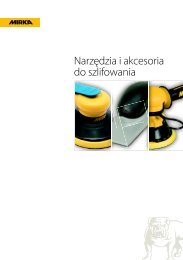ROS 125 150 mm.pdfTélécharger - Mirka
ROS 125 150 mm.pdfTélécharger - Mirka
ROS 125 150 mm.pdfTélécharger - Mirka
Create successful ePaper yourself
Turn your PDF publications into a flip-book with our unique Google optimized e-Paper software.
MIRKA 12,000 RPM<br />
<strong>125</strong> <strong>mm</strong> (5 in.) & <strong>150</strong> <strong>mm</strong> (6 in.)<br />
RANDOM ORBITAL SANDERS<br />
SERVICE INSTRUCTIONS<br />
NOTICE: To receive any expressed or implied warranty, tool must be repaired by an authorized <strong>Mirka</strong> Service Center. The following<br />
general service instructions provided are for use after completion of the warranty period.<br />
DISASSEMBLY INSTRUCTIONS<br />
Changing Grips:<br />
1. The (25) Grip has two “tabs” that wrap around the body of the<br />
sander under the inlet and exhaust. Use a small screwdriver<br />
to pick out one of the “tabs” of the Grip, and then continue to<br />
go underneath the Grip with the screwdriver and pry the Grip<br />
off of sander. To install a new Grip, hold the Grip by the tabs<br />
making them face outward, align the Grip and slide it under<br />
the (23) Throttle Lever then press the Grip down until it seats<br />
onto the top of the sander. Make sure the two “tabs” seat<br />
under the inlet and exhaust.<br />
Motor Disassembly:<br />
1. Lightly secure the tool in a vise using the (MPA0026) T-7 Soft<br />
Collar or padded jaw vice and remove the (36) pad with the<br />
(35) 24 <strong>mm</strong> Pad Wrench then remove the Shroud or Skirt<br />
(whichever applies).<br />
2. Remove the (12) Lock Ring with the (MPA0025) T-6 Motor<br />
Lock Ring Wrench/Spindle Puller Tool. The motor assembly<br />
can now be lifted out of the (27) Housing.<br />
3. Secure the motor assembly by clamping the (13) Shaft<br />
Balancer in a padded jaw vise and remove the (1) Retaining<br />
Ring and the (5) O-Ring from the (4) Cylinder.<br />
4. Remove the (3) Rear Endplate. This may require supporting<br />
the(3) Rear Endplate with a (MPA0416) Bearing Separator<br />
and lightly pressing the shaft through the (2) Bearing and<br />
Rear Endplate. Remove the (4) Cylinder and the five (7)<br />
Vanes and (6) Rotor Set from the shaft of the Shaft Balancer.<br />
Remove the (8) Key then press off the (9) Front Endplate<br />
(with [10] Bearing), (11) O-Ring and the (12) Lock Ring. It<br />
may be necessary to remove the Bearing with a Bearing<br />
Separator if it came out of the Front Endplate and stuck to the<br />
shaft of the Shaft Balancer.<br />
5. Remove and discard (61) Dust Shield from the (13) Shaft<br />
Balancer.<br />
6. Remove the bearing(s) from the endplates by using the<br />
(MPA0036) T-8 Bearing Removal Tool to press out the bearings.<br />
Shaft Balancer and Spindle Disassembly:<br />
1. Grip the shaft end of the (13) Shaft Balancer in a padded<br />
vise. With a thin screwdriver pick out the slotted end of the<br />
(21) Retaining Ring and peel out.<br />
2. Screw the threaded end of the (MPA0025) T-6 Motor Lock<br />
Ring Wrench/Spindle Puller Tool into the (22) Spindle until<br />
hand tight. Apply a gentle heat from a propane torch or hot<br />
air gun to the large end of the Balancer Shaft until it is about<br />
100° C (212° F) to soften the adhesive. Do not over heat. Remove<br />
the Spindle assembly by using the slider to give sharp<br />
outward blows to the Spindle. Allow the parts to cool so they<br />
are safe to handle. Follow one of the appropriate directions<br />
below:<br />
• If the Bearing comes out with the spindle, use a small<br />
Bearing Separator to remove it. Move onto step 3.<br />
• If the Bearing stays in the (13) Shaft Balancer. Follow<br />
steps A - D below.<br />
Procedure for removal of the Bearings from the Shaft<br />
Balancer:<br />
A. Position the Set Screw in the top of the (MPA0059) T-9 12<br />
<strong>mm</strong> ID Bearing Puller.<br />
B. Make sure the (21) Retaining Ring is removed, then press the<br />
Bearing Puller into the I.D. of Bearing until the Bearing Puller<br />
hits the bottom of the Shaft Balancer.<br />
C. Thread the Set Screw down until it hits the bottom of the (13)<br />
Shaft Balancer or becomes very tight. Grip the shaft end of<br />
the Shaft Balancer in a padded vise.<br />
D. Screw the threaded end of the (MPA0025) T-6 Motor Lock<br />
Ring Wrench/Spindle Puller Tool into the Bearing Puller until<br />
hand tight. Apply a gentle heat from a propane torch or hot<br />
air gun to the large end of the (13) Shaft Balancer to re-heat<br />
it until it is about 100° C (212° F) to soften the adhesive. Do<br />
not over heat. Remove the Bearing by using the slider to give<br />
sharp outward blows to the Bearing Puller. Allow the Bearing<br />
Puller, Bearing and Shaft Balancer to cool. After cooling,<br />
unthread the T-6 Motor Lock Ring Wrench/Spindle Puller<br />
Tool from the Bearing Puller. Back off the set screw. Secure<br />
the Bearing Puller and Bearings in a Bearing Separator and<br />
press out the Bearing Puller.<br />
3. The AirSHIELD components are held in place by the light<br />
press fit of the (16) Retainer. These components can be<br />
damaged during removal and may need to be replaced if<br />
removed. To remove the Retainer, use an O-ring pick or a #8<br />
sheet metal screw to grip and pull out the Retainer. Remove<br />
the (15) Valve and (14) Filter from the bore in the Shaft<br />
Balancer. If the Retainer and Valve were not damaged, they<br />
can be reused. However, the filter should be replaced on<br />
re-assembly.<br />
4. Remove the (18) bearing from the (22) Spindle. Remove<br />
the (19) Spacer, (62) Dust Shield and (20) Washer from the<br />
Spindle. Discard Dust Shield.<br />
Housing Disassembly:<br />
1. For Non-Vacuum (NV) and Central Vacuum (CV) machines<br />
follow the steps outlined in Section I below. For Self Generated<br />
Vacuum (SGV) machines follow the steps outlined in<br />
Section III.<br />
I. This section is for NV and CV machines.<br />
A) Unscrew the (39) Muffler Housing from the (27) Housing.<br />
B) Remove the (38) Muffler from the (39) Muffler Housing and<br />
remove the (37) Muffler insert from the cavity of the Muffler<br />
Housing.<br />
C) For NV machines move onto D. For CV machines move onto<br />
Section II.<br />
D) Remove the (32) NV Shroud. Move onto Step 2.<br />
II. This section continued from Section I for CV Exhaust machines:<br />
A) Remove the (58) Screw, (57) Washer and (55) Nut.<br />
B) Remove the (54 or 56) Swivel Exhaust Assembly from the (33<br />
or 34) Shroud.<br />
C) Remove the (33 or 34) Shroud from the (27) Housing. Move<br />
onto step 2.<br />
III. This section is for SGV Exhaust machines:<br />
A) Unscrew the (45) SGV Retainer with an (MPA0849) 8 <strong>mm</strong><br />
hex wrench.<br />
B) Remove the (47) Hose SGV Swivel Exhaust Assembly from<br />
the (27) Housing and (51) SGV Adapter.<br />
C) Pull the SGV Retainer out of the bore of the (47 or 50) Swivel<br />
Exhaust Assembly and remove the two (44) O-Rings.<br />
D) Remove the (33) Vacuum Shroud or (34) Vacuum Skirt from<br />
the (27) Housing. Move onto step 2.<br />
2. Place the (30) Speed Control to the midway position and<br />
remove the (31) Retaining Ring. NOTE: If the machine is a<br />
vacuum model, the vacuum exhaust must be removed (see<br />
Section 1 above for removal) before the (31) Retaining Ring<br />
can be removed with lock ring pliers. The Speed Control will<br />
now pull straight out. Remove the (29) O-Ring.<br />
3. Unscrew the (43) Inlet Bushing Assembly from the (27) Housing.<br />
Remove the (42) Valve Spring, (41) Valve, (40) Valve<br />
8


